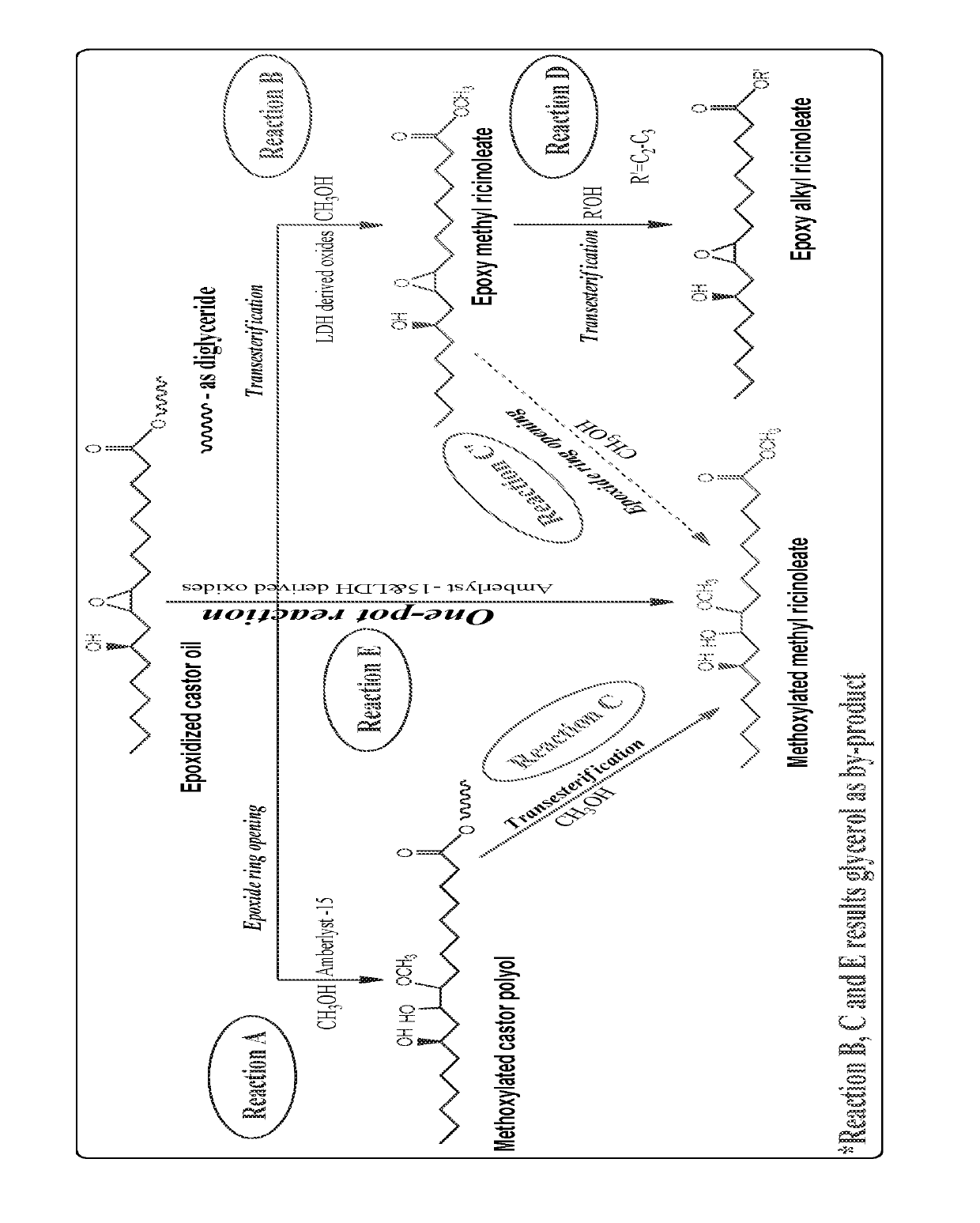Preparation of functionalized castor oil derivatives using solid acid and base catalysts
a technology of solid acid and base catalyst, which is applied in the direction of fatty acid chemical modification, organic chemistry, chemistry apparatus and processes, etc., can solve the problems of longer reaction time (15 h) and main drawback of process, and the use of homogenous phosphoric acid as catalyst is the main drawback, and the time required to prepare active catalysts is longer
- Summary
- Abstract
- Description
- Claims
- Application Information
AI Technical Summary
Benefits of technology
Problems solved by technology
Method used
Image
Examples
examples
[0068]Following examples are given by way of illustration and therefore should not be construed to limit the scope of the invention.
Example: 1
[0069]500 mg of epoxidized castor oil (shortly ECO; Mol. wt. ˜980) and 1 g of methanol (Methanol:ECO molar ratio=60:1) were taken along with 5 ml of toluene in a 25 ml round bottom (R.B.) flask at 27° C. 25 mg (5 wt. % w.r.t. oil) of solid acid catalyst (except MgAl3-LDH which is basic in nature) was added to the flask. The flask was then placed in a preheated oil bath at 60° C. and stirred well for 4 h. Catalyst (resin catalysts) was separated from the reaction mixture by simple decantation (sulphated zirconia and MgAl3-LDH were separated by centrifugation). Excess methanol and toluene were distilled out to get the ring-opened product and the solvent free sample was analyzed by 1H NMR. The conversion of ECO was 9-34% and the results are given in Table 1.
[0070]
TABLE 1Ring opening of ECO using different catalystsCatalystConversion of ECO (%)Amb...
example
[0092]12.5 of CO was blended with 12.5 g of ECO (1:1 w / w % ratio) at 27° C. and mixed well by glass rod to get homogeneous product. The same procedure was repeated for the preparation of castor derived blended derivatives using functionalized castor derivatives such as ring-opened glyceryl ricinoleates, epoxy alkyl ricinoleates and ring-opened alkyl ricinoleates as blending sources and the physical properties of the blended derivatives are given in Table 4.
[0093]
TABLE 4Physical properties of 1:1 w / w % ratio blendedfunctionalized castor derivativesViscosityOxidativeOxidative(Cp)stability atstability atDerivative 1Derivative 2at 25° C.30° C. (h)110° C. (h)COECO972495115MCPIPCP164412983MREMR245051194EMREPR7234510270MMRIPMR1032121
PUM
| Property | Measurement | Unit |
|---|---|---|
| temperature | aaaaa | aaaaa |
| temperature | aaaaa | aaaaa |
| viscosity | aaaaa | aaaaa |
Abstract
Description
Claims
Application Information
 Login to View More
Login to View More - R&D
- Intellectual Property
- Life Sciences
- Materials
- Tech Scout
- Unparalleled Data Quality
- Higher Quality Content
- 60% Fewer Hallucinations
Browse by: Latest US Patents, China's latest patents, Technical Efficacy Thesaurus, Application Domain, Technology Topic, Popular Technical Reports.
© 2025 PatSnap. All rights reserved.Legal|Privacy policy|Modern Slavery Act Transparency Statement|Sitemap|About US| Contact US: help@patsnap.com


